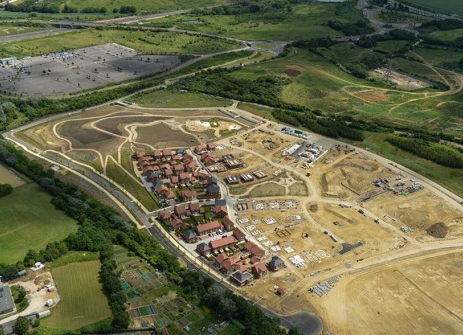
March 5, 2018, by lgzsam1
Using System Dynamics for Sustainable Water Management in Ebbsfleet: Part 1
In this blog, the first in a series on the use of system dynamics for developing a sustainable urban water management strategy in Ebbsfleet, colleagues from across the Urban Flood Resilience consortium outline plans for using this novel participatory technique, and report on the outcomes of the first modelling workshop.
Introduction and case study site
There is an increased recognition that the problems we face today, many manifesting on a global scale, cannot be addressed by individual actors alone, whether they represent the government, private entities or the third sector. One example of such is urban flooding, which is particularly prevalent in the UK. It is widely recognised that pluvial, tidal and fluvial flooding (as well as combined events) are exacerbated by climate change, with future projections showing an increased intensity and frequency of rainfall events. Urban creep and intensification with little attention to drainage can further increase flood risk. This poses a number of challenges for the large numbers of new developments which are planned in response to the demand for new homes, and the UK Government’s strategy to significantly increase housing supply. These require a sustainable water strategy, which addresses not only current challenges, but accounts for an uncertain future.
The Urban Flood Resilience project aims to manage flood risk by promoting a transformative approach to water management. Central to this approach is the achievement of coordinated planning, design and operation of urban water systems. Closely aligned with this objective is the involvement of key stakeholders and a focus on promoting collaborative governance. We aim to showcase this approach in Ebbsfleet, Kent. Ebbsfleet is a new garden city, where over 12000 houses have been planned and are currently being delivered. Ebbsfleet Development Corporation has been established by the Government to oversee the delivery of the garden city principles. This is a planning and design concept which aims to deliver high quality development in addition to improved environmental outcomes (Figure 1).

Figure 1: Artists rendition of the Ebbsfleet development. Courtesy of Ebbsfleet Development Corporation.
Delivering a system dynamics model
In order to deliver the core objectives of the research consortium in Ebbsfleet, we have set up a Learning and Action Alliance (LAA). An LAA is an open, collaborative arrangement where local stakeholders develop a joint understanding of local problems and possible solutions through rational criticism, consensus-building and discussion. One of the main activities we are trialling as part of the Ebbsfleet LAA is the development of a system dynamics model, which will allow us to explore sustainable urban management in a more structured way, and to understand where crucial future policy interventions might be best focused.
System dynamics allows us to model the system structure and to investigate the behaviour of that system over time. It is particularly useful for supporting decision-making at a strategic, system-wide level and exploring the long-term consequences of alternative policies.
While a System Dynamics model can be developed by experts alone, building it collaboratively allows it to benefit from the knowledge base held by local stakeholders.
This helps foster a feeling of ownership by the stakeholders, who will also be more likely to adopt and further recommend the model’s policy solutions. Most importantly, stakeholders bring to the table invaluable local knowledge and have a much better understanding of how the system in question works in practice.
Generally speaking, the system dynamics model has five stages (according to Stave, 2002):
- Define the problem
- Conceptualise the problem – seek problem causes by exploring the structure of the model
- Build a computer simulation model of the system – developing reference modes, building the stock and flow diagram, eliciting the feedback structure, writing equations and parameterisation
- Test the model and develop policies
- Simulate policies and make recommendations
Workshop 1: Defining the problem
The first workshop was held on the 28th of November 2017 and focused on the first stage of the model: problem definition.
For the opening task, stakeholders were split into two groups, to discuss the main problem dimensions and metrics for each problem dimension (Figure 2). The local stakeholders were tasked with identifying the problem dimensions and metrics, while the role of the research team was to lend their expertise on the feasibility of modelling the problem dimensions proposed. The initial map that was produced in groups identified seven problem dimensions, with up to three metrics for each.
The second task consisted of merging the two group maps and arriving at a consensus on a maximum of five variables. The process was one of understanding which problem dimensions overlapped and which ones could be incorporated into other dimensions. The combined list was then ordered by importance, with the most relevant five dimensions making the cut (Table 1 and Figure 3).
Table 1: Problem dimensions identified by the two groups, showing those duplicated by both groups (x2) and those that were incorporated into others or removed from the final list (strikethrough text)
Looking forwards
The next LAA will focus on identifying the variables for the remaining four problem dimensions, so that the participants are then armed with all of the different elements of the model. These variables will become the building blocks from which we construct the system dynamics model – so it is important that we spend sufficient time ensuring that we have taken everyone’s views and knowledge into account.
References
Stave, K. A. (2002). Using system dynamics to improve public participation in environmental decisions. System Dynamics Review. 18, 139-167.
This blog was a collaborative effort by members of the Urban Flood Resilience team. For more information on the Ebbsfleet LAA contact Tudor Vilcan tudorel.vilcan@open.ac.uk . For more information on the system dynamics method being used in Ebbsfleet contact Shaun Maskrey shaun.maskrey@nottingham.ac.uk.
No comments yet, fill out a comment to be the first




Leave a Reply